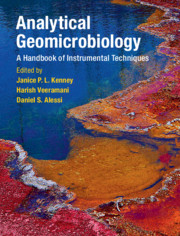Book contents
- Analytical Geomicrobiology A Handbook of Instrumental Techniques
- Analytical Geomicrobiology
- Copyright page
- Contents
- Contributors
- Foreword
- Part I Standard Techniques in Geomicrobiology
- Part II Advanced Analytical Instrumentation
- Part III Imaging Techniques
- Part IV Spectroscopy
- 9 X-ray Diffraction Techniques
- 10 Application of Synchrotron X-ray Absorption Spectroscopy and Microscopy Techniques to the Study of Biogeochemical Processes
- 11 Bacterial Surfaces in Geochemistry – How Can X-ray Photoelectron Spectroscopy Help?
- 12 Applications of Fourier-transform Infrared Spectroscopy in Geomicrobiology
- 13 Mössbauer Spectroscopy
- Part V Microbiological Techniques
- Index
- References
10 - Application of Synchrotron X-ray Absorption Spectroscopy and Microscopy Techniques to the Study of Biogeochemical Processes
from Part IV - Spectroscopy
Published online by Cambridge University Press: 06 July 2019
- Analytical Geomicrobiology A Handbook of Instrumental Techniques
- Analytical Geomicrobiology
- Copyright page
- Contents
- Contributors
- Foreword
- Part I Standard Techniques in Geomicrobiology
- Part II Advanced Analytical Instrumentation
- Part III Imaging Techniques
- Part IV Spectroscopy
- 9 X-ray Diffraction Techniques
- 10 Application of Synchrotron X-ray Absorption Spectroscopy and Microscopy Techniques to the Study of Biogeochemical Processes
- 11 Bacterial Surfaces in Geochemistry – How Can X-ray Photoelectron Spectroscopy Help?
- 12 Applications of Fourier-transform Infrared Spectroscopy in Geomicrobiology
- 13 Mössbauer Spectroscopy
- Part V Microbiological Techniques
- Index
- References
Summary
The need for increasingly detailed characterization of geomicrobiological or geochemical systems has necessitated the use of increasingly sophisticated analytical techniques that enable direct measurements of the atomic-scale parameters used in mechanistic models. From the characterization techniques available today, those utilizing penetrating X-rays have the distinct advantage of being able to probe environmental samples in their natural hydrated state, without the need for complicated sample preparation that could potentially alter the system and without the limitation of surface-only sensitivity that is typical of particle and optical probes. In addition, biogeochemical samples of interest are often noncrystalline and consist of many chemical components, which complicates their structural characterization by conventional techniques. We will discuss how the methods of synchrotron X-ray absorption spectroscopy (XANES and EXAFS) overcome many of these limitations to provide the chemically specific, molecular-scale information needed to unravel the mechanisms controlling biogeochemical processes. Current X-ray focusing technology is capable of providing hard X-ray beams in the nanometer size range, which enables the application of X-ray fluorescence (XRF) spectroscopy techniques at spatial resolutions comparable to those of scanning electron microscopy, but with approximately 1000-fold higher elemental sensitivity. These methods can be applied to a diverse range of environmental systems, such as adsorption of heavy metals to minerals, plants, or bacterial cells, redox transformations of metals and radionuclides induced by microbial activity, biomineralization, nanomineral nucleation and precipitation, metal uptake, transport, and distribution within biomass, and many other areas of biogeochemistry.
Information
- Type
- Chapter
- Information
- Analytical GeomicrobiologyA Handbook of Instrumental Techniques, pp. 238 - 261Publisher: Cambridge University PressPrint publication year: 2019
References
10.6 References
Accessibility standard: Unknown
Why this information is here
This section outlines the accessibility features of this content - including support for screen readers, full keyboard navigation and high-contrast display options. This may not be relevant for you.Accessibility Information
- 7
- Cited by
